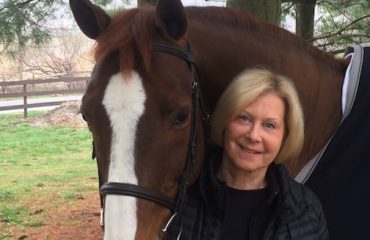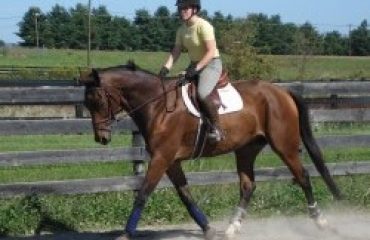
Photo by Lahorstman Photography
Shannon Peters is a U.S. Dressage Federation bronze, silver and gold medalist, and three-time National Championship competitor. She loves bringing young horses up through the levels, and competes regularly both in Southern California CDIs and other top shows. Shannon is married to Olympic dressage rider Steffen Peters, and together they operate Arroyo Del Mar in San Diego, California. Do you have a question you want Shannon to answer? Send questions to editor@sidelinesnews.com.
What are your daily and periodical routines for tack cleaning?
All of our tack is cleaned daily. Not always with glycerin, as it can strip the color from leather over time, but no tack goes back dirty — ever! Bits are cleaned thoroughly, and bridles and reins are wrapped and hung neatly. All tack is conditioned once per week. Any old glycerin is removed gently with a toothbrush in the hard-to-reach areas, to be sure there’s not buildup of any dirt, grime or sweat.
Can all horses be trained in dressage, or do some just genuinely not like it?
Of course! Not all horses have the willingness for, let’s say, above second level, but every horse benefits physically and mentally from proper dressage training. I’ve had several horses over the years that have switched disciplines, to either hunter-jumper or 3-day eventing, as it was what made the horse the happiest, but I always felt great providing those horses great basics and allowing them to carry on in a discipline where they thrived. I have several horses currently that jump once per week, and doing that has not only helped them physically, but mentally to stay sharp and eager to continue climbing the levels.
What do you look for in fitting a saddle to a horse and rider?
This is a pet peeve of mine! I see few saddles that are fitted properly to horse or rider! It has to be both to really work in a successful way to build a horse’s top line correctly, and put the rider in the best possible position to be successful. I want to see that the horse is comfortable, and that the saddle sits level and balanced on the horse’s back without a whole lot of extra padding to keep it that way. I’m not saying that at times you may not need to make small adjustments in saddle fit, let’s say until a qualified saddle fitter is coming out, or maybe waiting for a new saddle. But it shouldn’t really be standard practice. As for the rider, I want to see that they sit in the center of the saddle, in the most balanced point. I see far too many riders ending up in the cantle of their saddle, which puts them behind the motion of the horse, as well as increasing the pressure in an uneven way on the horse’s back. I want to see good natural seat and leg alignment that doesn’t look forced and that the rider’s leg drapes naturally on the sides of the horse. I also look for a balanced upper body position that looks natural, and that can only happen from a balanced seat.
Have you ever disagreed with a judge’s score? What did you do?
Sure, I think every rider has at some point. We often have a different feeling in the saddle, or see the test from a different vantage point than the judge has. I video all of my tests for that exact reason, so I can go back and see, with my own eyes, what the judge may have seen that day. The test can feel very different than it looked, and sometimes it gives the rider a better perspective on what the judge saw that day. Judges are also human, and occasionally, things are missed. We are all human, and need to keep that perspective.
Do you have any tips for a beginning rider on developing “feel”?
Feel is something that’s harder to develop. Teaching a rider to “feel” has many moving parts. Most beginning riders need to get over the initial fear factor to start developing feel. If a rider’s legs are clamping, arms are holding or seat is braced, there’s no part of that position that can “feel” anything. Most riders need to try and stop “thinking” so much and start feeling what’s going on underneath them. So starting out with a good, patient instructor who can teach the rider proper position, correct use of the basic aids (go, stop, turn), will go a long way in developing basic “feel.”













